Table of Contents
Introduction
According to Nuts Statistics, Nuts, characterized as seeds enclosed within tough shells, are well-known for their abundant nutritional value, containing protein, healthy fats, and vitamins. They are available in various types like almonds, walnuts, and cashews, and are widely consumed globally, both as snacks and in culinary uses.
Nuts offer potential health benefits, and their popularity continues to grow, finding application in diverse culinary creations, including cooking, baking, and as components in various food items.
However, the industry faces challenges like the effects of climate change and concerns related to allergies. Strict regulations govern the nuts market to ensure product safety and quality.
Editor’s Choice
- The Global Nuts market generated a revenue of USD 63.2 billion in 2023.
- Offline distribution, which includes traditional brick-and-mortar stores and physical retail outlets, commands a significant majority with a substantial market share of 84.6%.
- In 2019, North America led the way with a market value of 7,639 million U.S. dollars, and this figure steadily increased year by year, reaching 10,764 million U.S. dollars in 2026.
- The 2021-2022 and 2022-2023 seasons saw a decline in almond production, with figures of 1,675,839 metric tons and 1,477,505 metric tons, respectively.
- Notably, in the 2021-2022 season, cashew production witnessed a substantial surge, reaching an impressive 10,86,270 metric tons, and this growth trend continued into the 2022-2023 season, with production hitting 10,95,030 metric tons.
- India led the way in cashew consumption, with a substantial 3,22,160 metric tons consumed, indicating a strong affinity for cashews in the Indian market.
- Cashews emerged as the clear winner, with 31.15% of respondents declaring them their top choice.
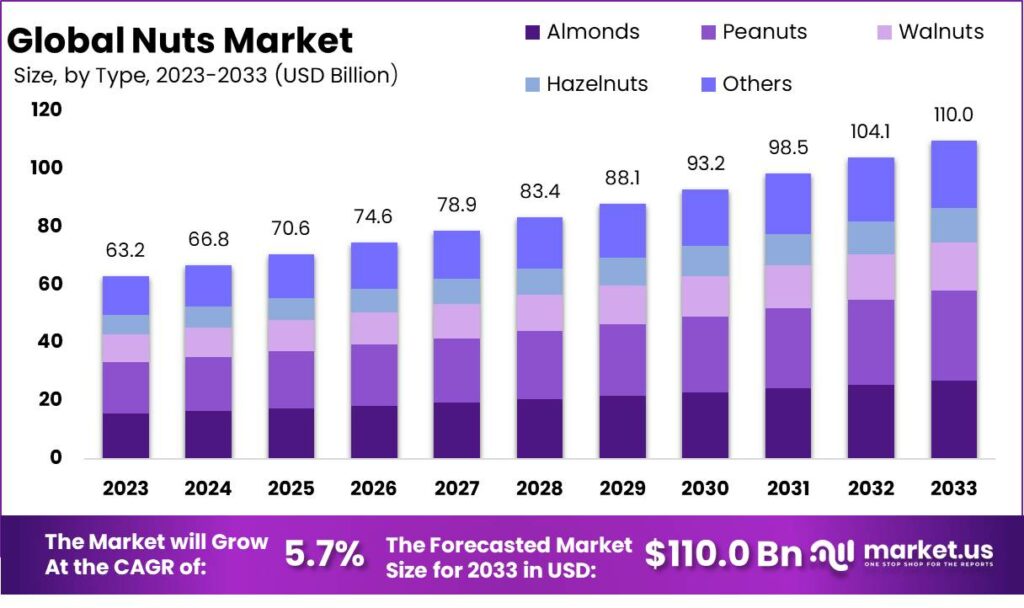
Global Nuts Market Overview
Global Nuts Market Size
- The revenue of the global nuts market is projected to exhibit steady growth over the coming decade at a CAGR of 5.7%.
- In 2023, the market’s revenue is estimated at USD 63.2 billion, and this figure is expected to rise to USD 66.8 billion in 2024.
- The positive trend persists with projected revenues of USD 93.2 billion in 2030 and USD 98.5 billion in 2031.
- By 2032, the global nuts market is expected to reach a revenue of USD 104.1 billion, ultimately surpassing the USD 110.0 billion mark in 2033.
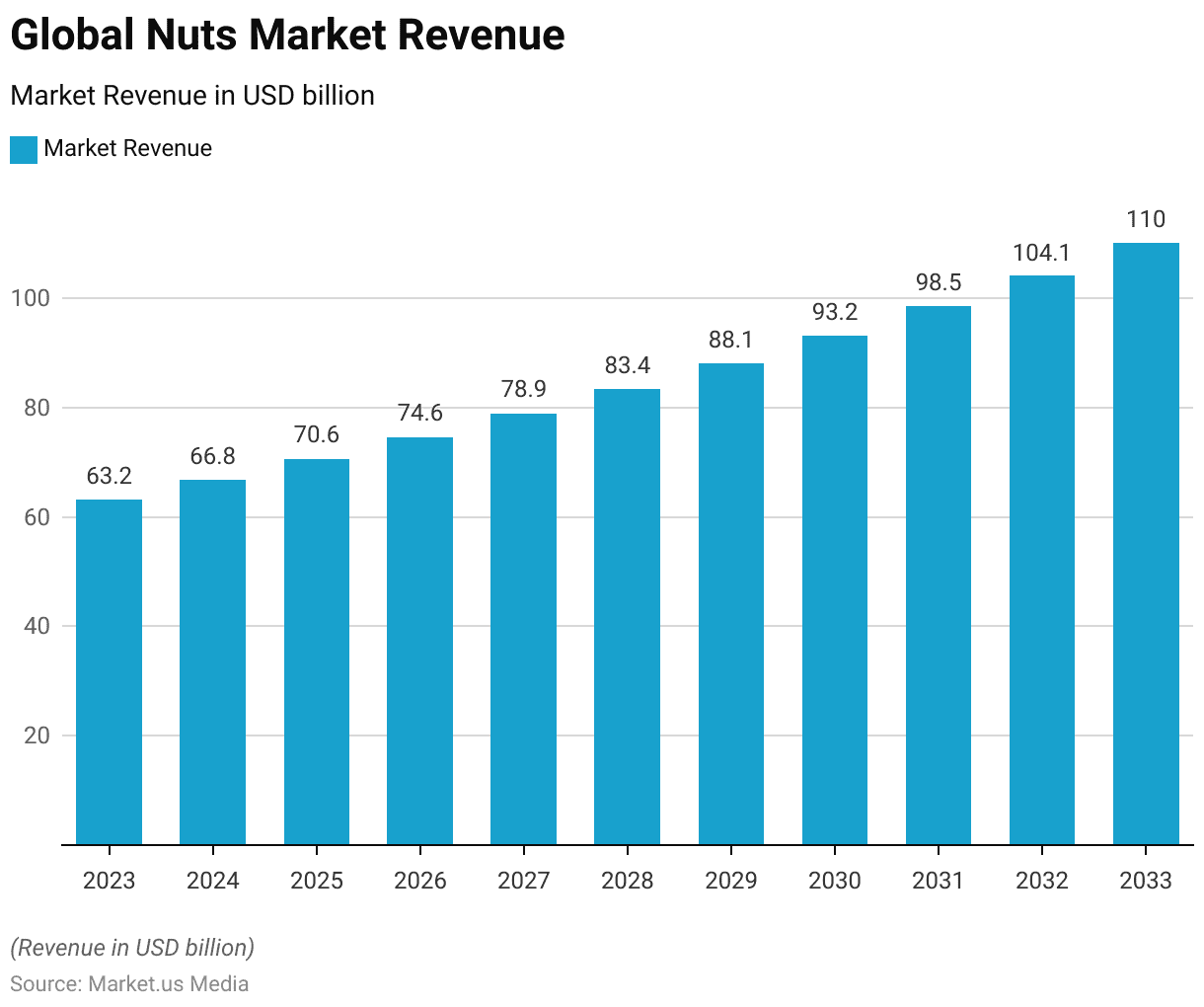
Nuts Market Share – By Distribution Channel
- Offline distribution, which includes traditional brick-and-mortar stores and physical retail outlets, commands a significant majority with a substantial market share of 84.6%.
- In contrast, the online distribution channel, encompassing e-commerce platforms and digital retail channels, holds a comparatively smaller market share of 15.4%.
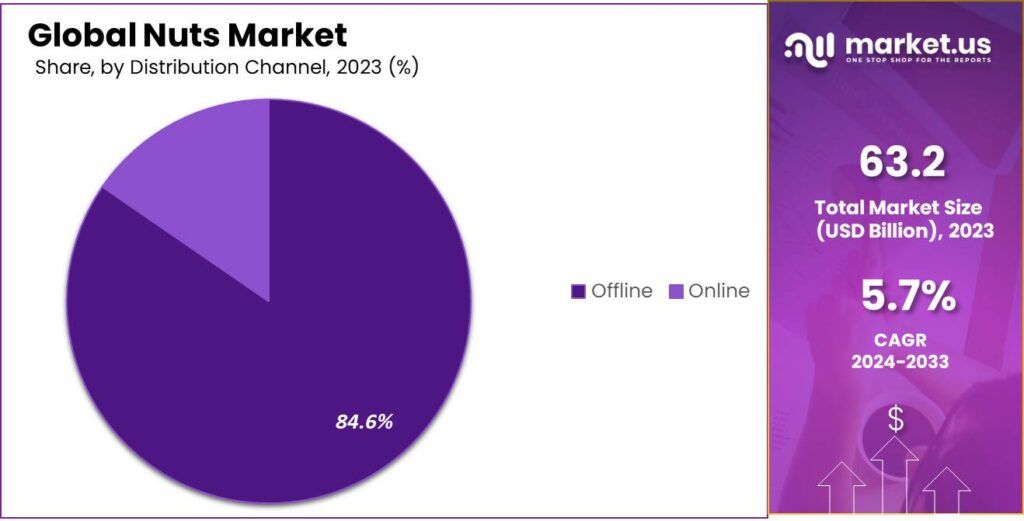
Nuts and Seeds Market Revenue – By Region
- In 2019, North America led the way with a market value of 7,639 million U.S. dollars, and this figure steadily increased year by year, reaching 10,764 million U.S. dollars in 2026.
- Europe, on the other hand, began with a market value of 6,396 million U.S. dollars in 2019 and witnessed a continuous upward trend, culminating in a value of 8,459 million U.S. dollars in 2026.
- The Asia-Pacific region displayed remarkable growth throughout this period, starting at 8,303 million U.S. dollars in 2019 and surging to an impressive 15,904 million U.S. dollars in 2026, making it a substantial contributor to the global market.
- The Rest of the World region also experienced growth, albeit at a slightly slower pace, starting at 2,494 million U.S. dollars in 2019 and reaching 3,625 million U.S. dollars in 2026.
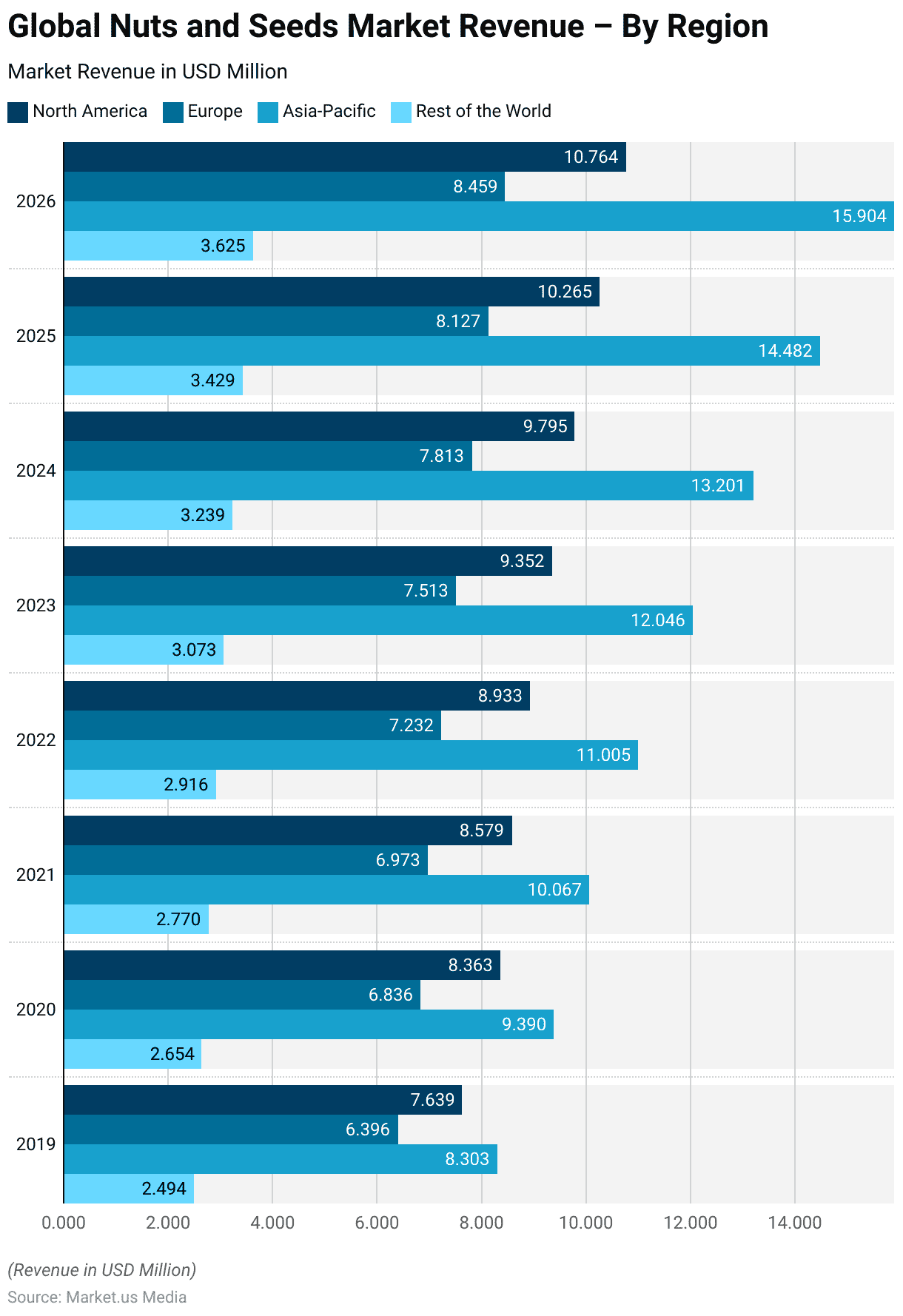
Nutritional Value of Nuts
- FoodData Central provides comprehensive nutritional information for “Nuts, mixed nuts, oil roasted, with peanuts, with salt added (SR Legacy, 168600)” in a 100-gram portion.
- This nut and seed product contains 2.08 grams of water and provides an energy value of 607 calories (equivalent to 2540 kJ).
- It is rich in protein, with 20 grams per 100 grams, and offers a substantial fat content of 54 grams, including saturated, monounsaturated, and polyunsaturated fats.
- Carbohydrates are present at 21 grams, with dietary fiber accounting for 7 grams and total sugars at 4.15 grams, which include various types such as sucrose and glucose.
Global Nuts Production Statistics
Almond Production
- In the 2012-2013 season, almond production stood at approximately 1,072,135 metric tons, and it continued to hover around this range in the subsequent years.
- Subsequently, global almond production witnessed a consistent upward trend, surpassing 1,400,000 metric tons in the 2019-2020 season and further surging to an impressive 1,738,700 metric tons in the 2020-2021 season.
- However, the 2021-2022 and 2022-2023 seasons saw a decline in almond production, with figures of 1,675,839 metric tons and 1,477,505 metric tons, respectively.
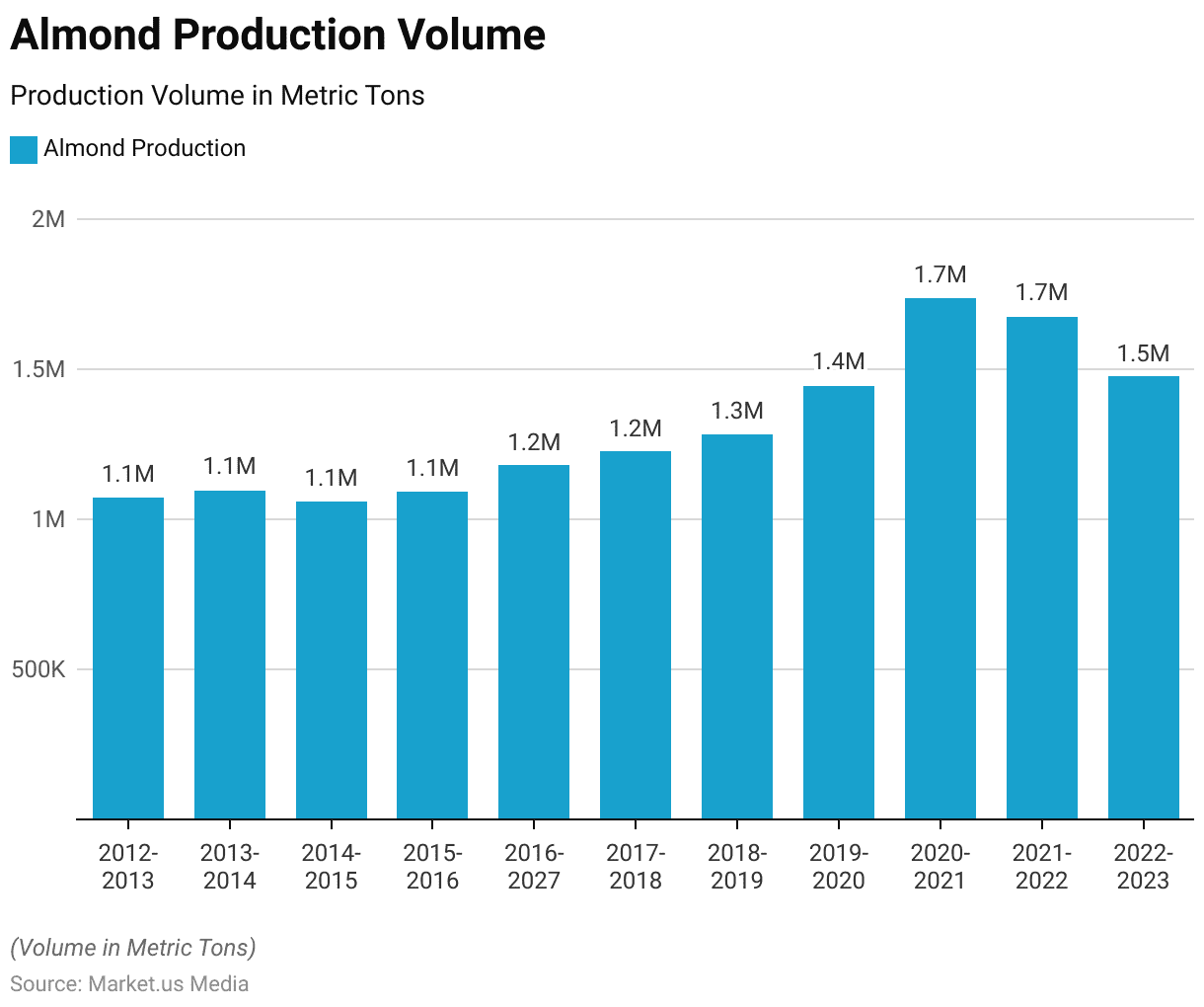
Brazil Nuts Production
- Brazil nut production has displayed a diverse pattern over the past decade, reflecting various factors impacting the industry.
- In the 2012-2013 season, production reached 28,880 metric tons, but it began to fluctuate in the subsequent years.
- The subsequent years displayed some level of stability, with production figures ranging from 29,700 metric tons in 2020-2021 to 25,000 metric tons in 2021-2022.
- The 2022-2023 season witnessed a moderate increase in Brazil nut production, reaching 28,000 metric tons.
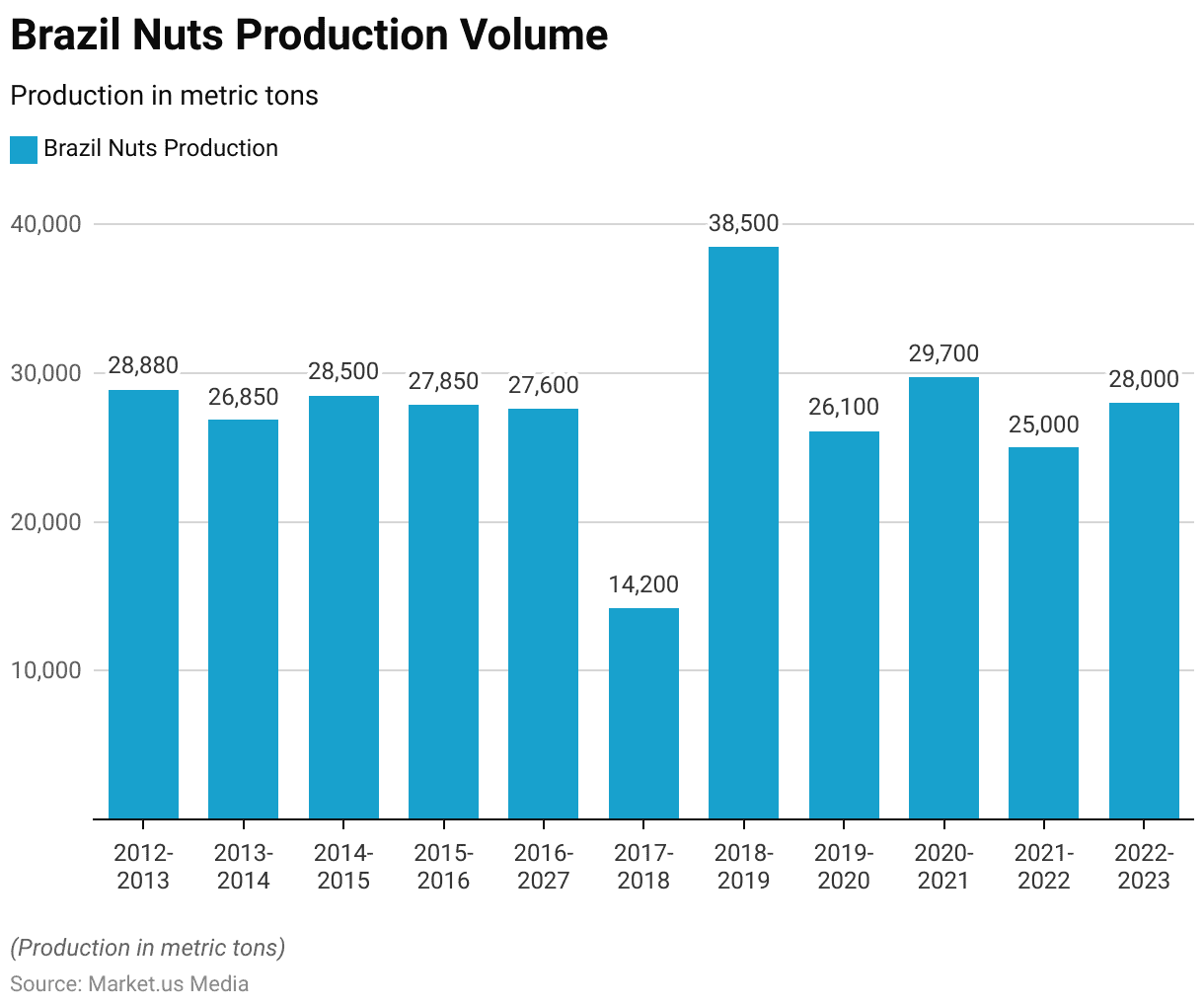
Cashews Production
- Cashew production has shown a significant and consistent upward trend over the past decade. In the 2012-2013 season, cashew production started at 549,692 metric tons and steadily increased year by year.
- Subsequent years also maintained high levels of cashew production, consistently exceeding 7 million metric tons.
- Notably, in the 2021-2022 season, cashew production witnessed a substantial surge, reaching an impressive 10,86,270 metric tons, and this growth trend continued into the 2022-2023 season, with production hitting 10,95,030 metric tons.
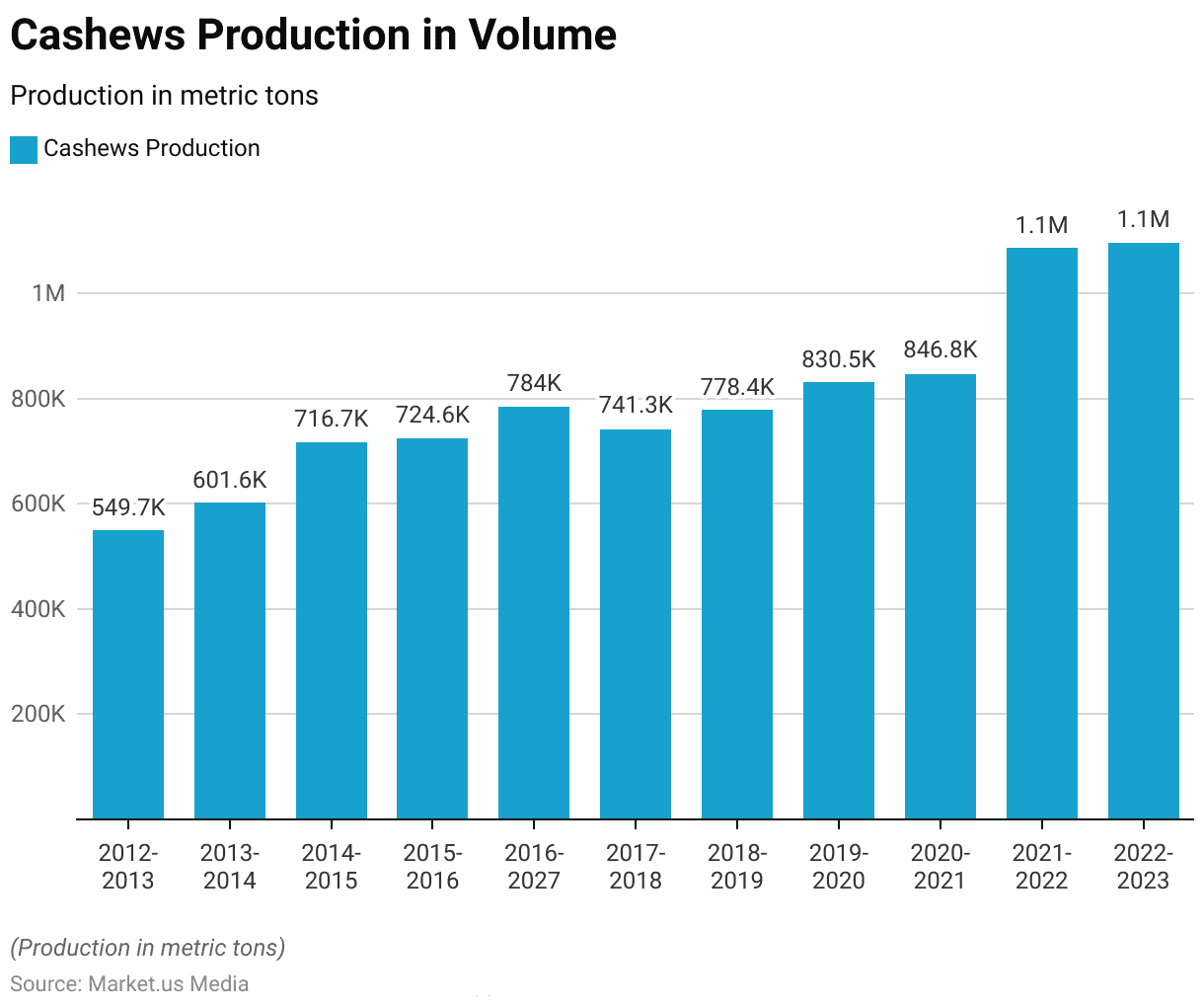
Nuts Consumption Statistics
Almond Consumption
- The United States led in almond consumption in 2021, with a substantial 3,30,258 metric tons consumed, underscoring its popularity among American consumers.
- India followed with 1,61,590 metric tons, indicating a significant appetite for almonds in the Indian market.
- Spain and China also demonstrated notable almond consumption, with 1,03,935 metric tons and 94,947 metric tons, respectively.
- Germany and Italy contributed to European almond consumption, consuming 86,933 metric tons and 62,841 metric tons, respectively.
- In Asia, Japan registered 49,047 metric tons of almond consumption, while France accounted for 46,123 metric tons in Europe.
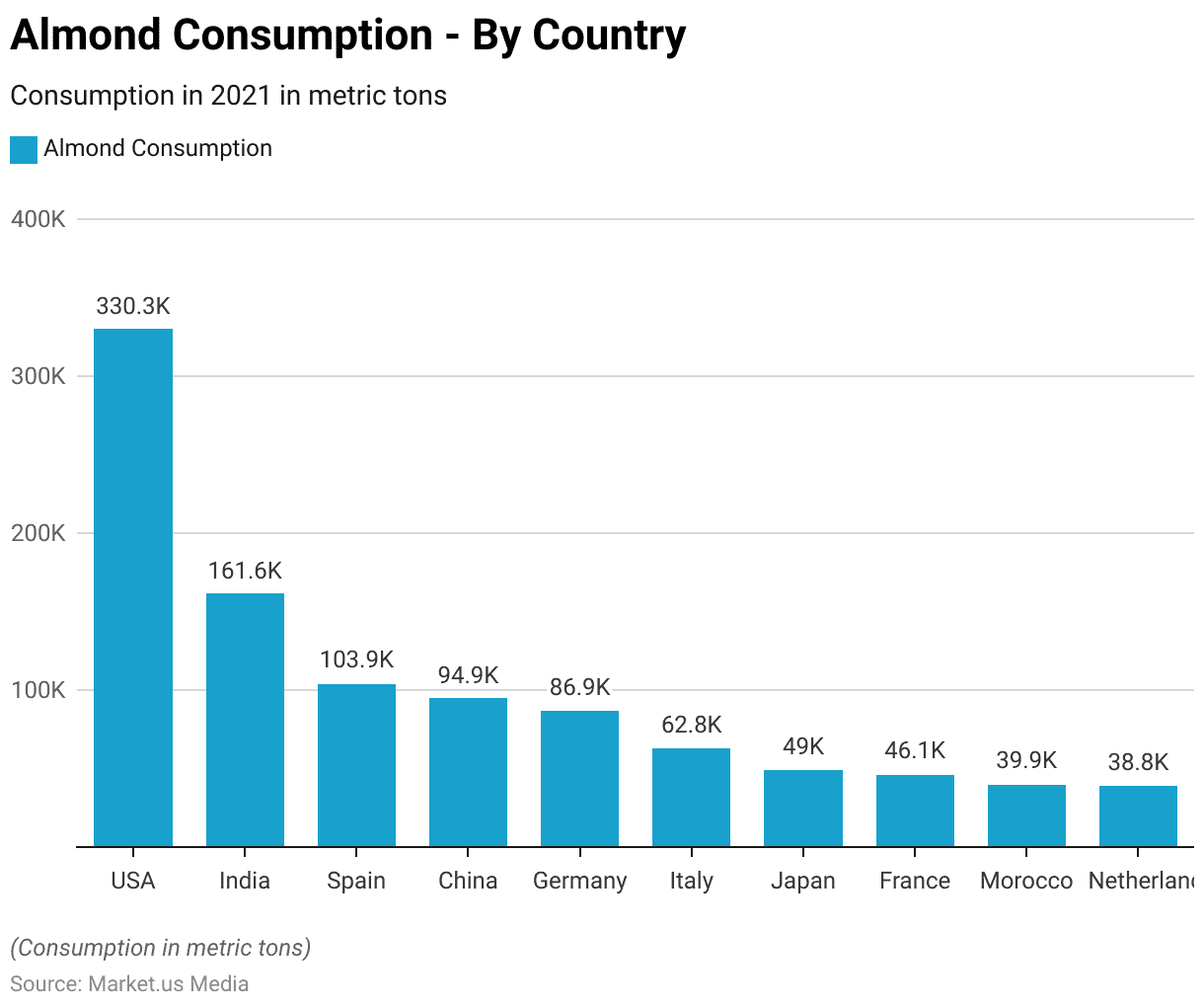
Brazil Nuts Consumption
- The United States led in Brazil’s nuts consumption in 2021, with a notable 6,390 metric tons consumed, indicating a strong demand for these nuts among American consumers.
- The Netherlands closely followed with 6,385 metric tons, reflecting their popularity in the Dutch market.
- Germany and the United Kingdom also demonstrated significant Brazil nuts consumption, with 3,634 metric tons and 3,500 metric tons, respectively.
- South Korea, Russia, and Canada displayed a growing interest in Brazil nuts, with consumption figures of 2,101 metric tons, 1,342 metric tons, and 1,315 metric tons, respectively.
- France, Colombia, and Vietnam also contributed to global consumption, with figures of 1,147 metric tons, 1,121 metric tons, and 956 metric tons, respectively.
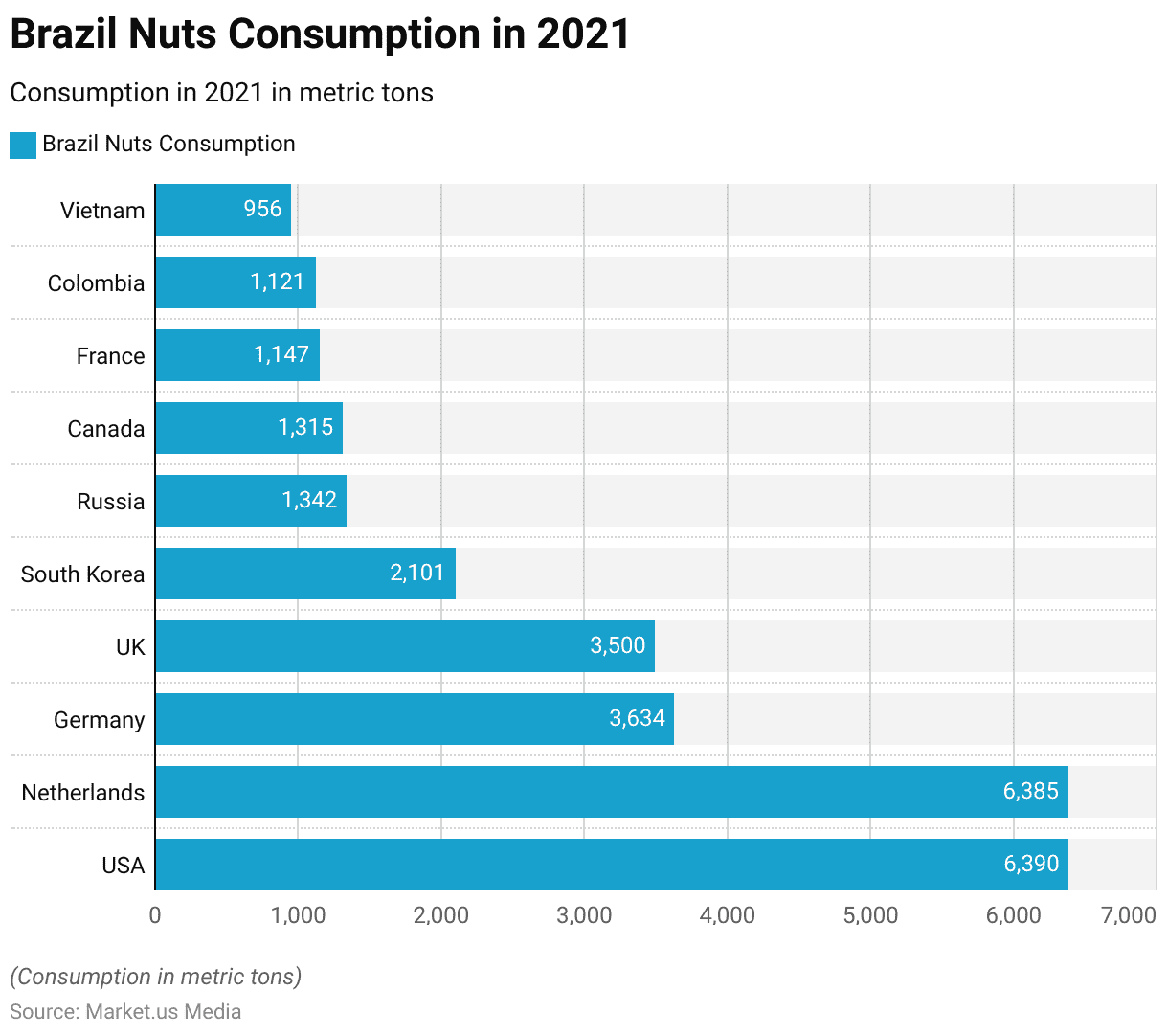
Cashews Consumption
- In 2021, India led the way in cashew consumption, with a substantial 3,22,160 metric tons consumed, indicating a strong affinity for cashews in the Indian market.
- The United States followed with 1,82,814 metric tons, underscoring their popularity among American consumers.
- Germany, China, and the United Kingdom also displayed notable cashew consumption figures, with 53,621 metric tons, 35,063 metric tons, and 22,589 metric tons, respectively.
- France, Canada, Australia, and Russia contributed to global cashew consumption with figures ranging from 17,321 metric tons to 15,623 metric tons.

Consumer Preferences in Nut Consumption
- According to the findings of a Health Digest poll, 7.38% expressed a preference for walnuts.
- Meanwhile, Brazil nuts considered a less popular choice, garnered the favor of only 8.36% of respondents.
- Pecans were the preferred healthy nut for 9.67% of participants, while 18.52% leaned toward pistachios. Almonds came in as the preferred choice for 24.92% of respondents.
- Finally, cashews emerged as the clear winner, with 31.15% of respondents declaring them their top choice among healthy nuts in the poll.
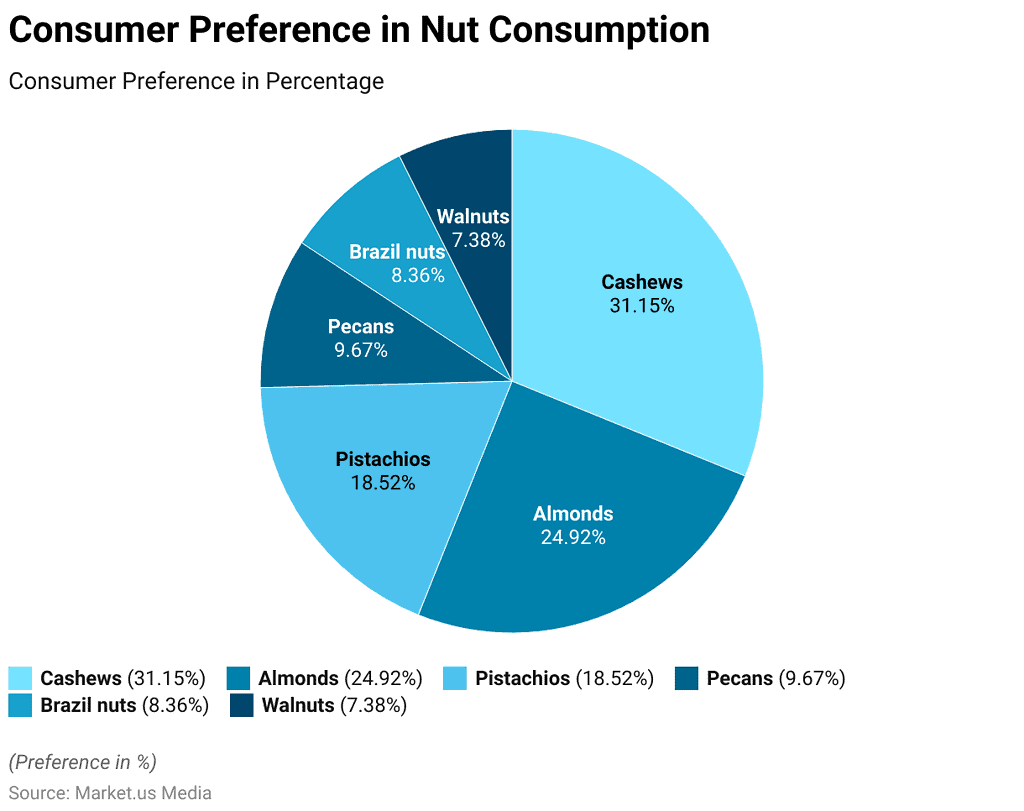
Food Safety Regulations for Nuts
- For Groundnut kernels, Moisture content should not exceed 7.0%.
- Damaged kernels, including slightly damaged ones, should not make up more than 5.0% of the batch, and aflatoxin content should not exceed 30 parts per billion.
- For Raisins, moisture content should not exceed 15.0%.
- Damaged raisins (sunburned, scarred, mechanically damaged) should not exceed 2.0%, and sugared raisins (those with visible sugar crystals) should not exceed 15.0%.
- For pistachio nuts, moisture content should not exceed 7.0%.
- Unopened shells (shells with kernels inside) should not exceed 2.0% and empty shells (shells without developed kernels) should not exceed 1.0%.
- For Dates, moisture content should not exceed 30.0% and ash insoluble in dilute HCl should not exceed 0.1%.
Discuss your needs with our analyst
Please share your requirements with more details so our analyst can check if they can solve your problem(s)



